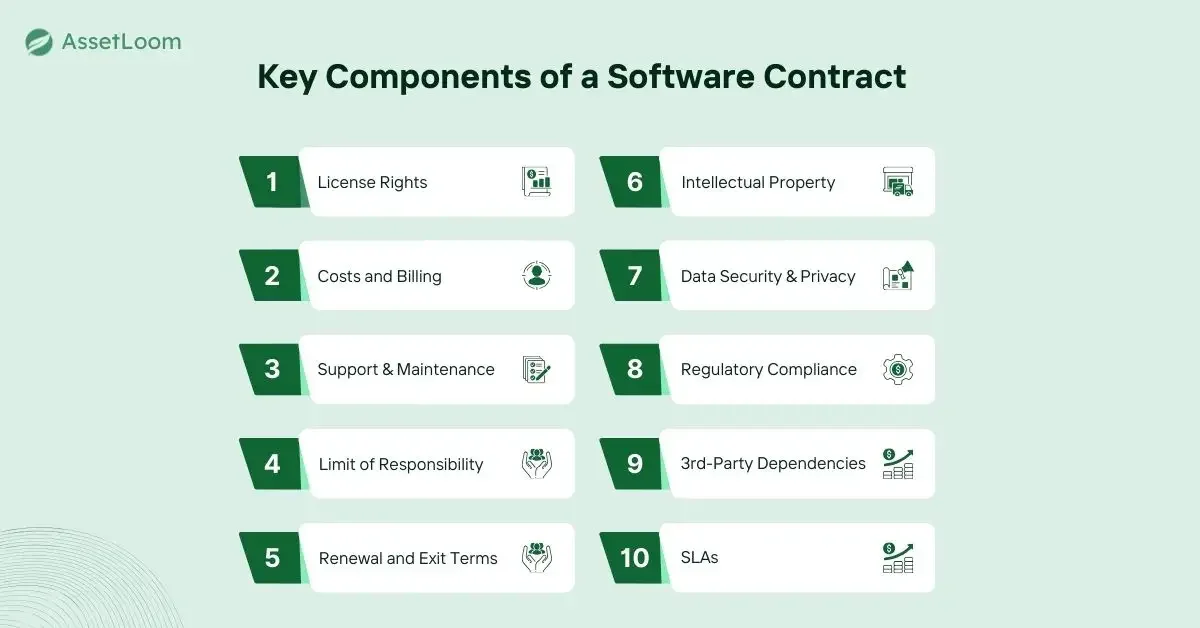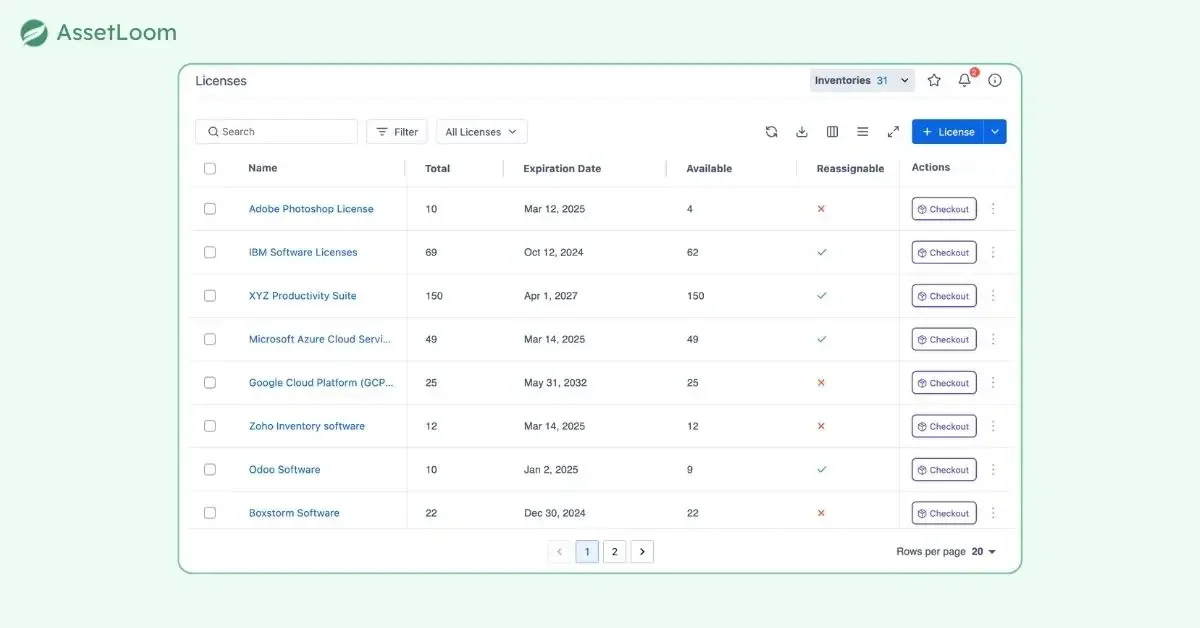Software Contracts: Fundamentals of Software Management
Learn what software contracts are, their key components, types, and how to manage, negotiate, or cancel them.
It is inevitable that most businesses today rely on software in their daily operations. From accounting tools that manage finances to project management platforms that organize tasks, software has become central to how companies work. Customer relationship systems, communication apps, and cloud storage solutions are now just as critical as traditional office equipment.
Behind every one of these applications sits an agreement between the software provider and the user. These agreements, known as software contracts, define the rules of access, cost, responsibilities, and protections for both sides. They are essential frameworks that govern how businesses can use the technology they depend on.
Knowing what software contracts cover, how to handle them, and when to end them can save money, reduce conflicts, and guide better decisions.
What are software contracts?
Software contracts are legally binding documents between software vendors and customers. They explain the conditions for using the software, including what you pay, how you can use the product, and the responsibilities of each party.
For example, if your company signs up for a cloud-based accounting tool, the contract might cover:
- How many employees can use it.
- What kind of support is included.
- How much you will pay and on what schedule.
- When the software contracts end.
- What happens if the vendor fails to meet service standards.
The contract ensures that expectations are clear. Without one, there is a higher risk of misunderstandings, hidden costs, or service disruptions. For vendors, it protects against misuse. For customers, it provides a level of accountability and clarity.
Learn more about vendor management.
Key Components of Software Contracts
Most software contracts include similar building blocks, even if the details differ. Understanding these parts makes it easier to review agreements before signing.

1. License Rights
This section specifies how you can use the software. Some licenses are limited to a single user, while others cover an entire organization. They can be permanent or time-limited. The more people or devices covered, the more valuable the license becomes.
2. Costs and Billing
The financial section explains whether the software is purchased outright or accessed through recurring fees. Many modern tools use a subscription model. Extra costs, such as fees for upgrades or adding users, should also be listed.
3. Support and Maintenance
Contracts often explain what kind of help you will receive. This may be limited to email during business hours or include full-time support. Maintenance can cover bug fixes and regular updates.
4. Limitation of Responsibility
This clause protects the vendor by limiting how much they can be held liable for. If the software fails and your business loses money, the contract may state that you can only recover an amount equal to what you have paid under the contract.
5. Renewal and Exit Terms
Some contracts renew automatically. Others require you to act if you want to continue. Exit terms explain how to end the agreement and whether any penalties apply.
6. Ownership and Intellectual Property
Vendors usually keep ownership of the software. Customers receive the right to use it under specific conditions. This section may also cover whether customization or integration is allowed.
7. Data Security and Privacy
Modern contracts often focus heavily on security. Look for clauses about data encryption, backups, and procedures if a breach occurs. These commitments are critical for protecting customer or company information.
8. Legal and Regulatory Compliance
If your company must follow strict rules, such as privacy laws, the contract should confirm that the vendor supports compliance. Examples include GDPR for European data or HIPAA for healthcare records.
9. Third-Party Dependencies
Some applications rely on outside tools. The contract should state who is responsible for those parts and what happens if they stop working.
10. Service-Level Agreements (SLAs)
An SLA sets performance promises. For example, a cloud service might guarantee 99.9 percent uptime. If the vendor fails to meet these standards, the agreement may provide compensation.
Types of Software Contracts
Not all software contracts are the same. Here are the main types of businesses encountered:
- Perpetual license: You buy it once and can use it forever. Often used for on-premise software.
- Subscription contract: You pay monthly or yearly to continue access. This is the most common for SaaS platforms.
- End-user license agreement (EULA): Typically short, designed for individuals, and focused on restrictions.
- Enterprise agreement: A large-scale contract that covers multiple products or services, often with discounts or custom terms.
- Support and maintenance contract: Sometimes separate from the main license, covering updates and technical help.
Each type has its pros and cons. Subscription agreements often spread out costs and include updates, while perpetual licenses avoid ongoing payments but may leave you without support unless you pay extra.
Fundamentals of Software Contract Management
Signing a contract is only the beginning. Keeping track of agreements is just as important. Effective contract management helps prevent overspending, ensures compliance, and reduces the risk of missed deadlines.
Practical steps include:
- Central storage – Keep all agreements and amendments in a single, accessible location.
- Reminders – Set up alerts for renewal dates and billing deadlines.
Read more: Top Tools for Managing Contract Expiration Reminders in 2025
- Regular reviews – Assess whether the terms are still suitable for your organization’s needs.
- Usage monitoring – Make sure you’re staying within license limits to avoid penalties.
- Compliance checks – Verify that vendor performance aligns with the SLAs in the contract.

List of software contracts in AssetLoom
Smart handling of software contracts helps cut costs, avoid problems, and make better choices.
The Role of a Contract Owner
Every software agreement should have a designated “owner” inside the organization. This person is responsible for overseeing the contract’s lifecycle and making sure it’s being followed.
Their duties usually include:
- Tracking when the contract is due for software renewal.
- Ensuring the software is used according to the agreed terms.
- Handling disputes or service issues with the vendor.
- Coordinating with legal or finance teams when changes are needed.
Having a clear owner avoids confusion and ensures accountability.
How to Negotiate Software Contracts
Good negotiation can create real savings and flexibility. Consider these steps:
- Clarify your needs: Decide how many users, which features, and what level of support you require.
- Ask for adjustments: Vendors may allow changes to pricing, user limits, or service details if requested.
- Check renewal rules: Avoid contracts that renew automatically without notice.
- Secure proper support: If the software is critical, make sure support levels match your business needs.
- Document agreements: Always ensure promises are written into the contract.
Cancelling a Software Contract
Ending an agreement can be necessary when needs change or costs rise. But it must be handled carefully:
- Read the exit terms: Understand penalties or notice periods.
- Give proper notice: Avoid automatic renewals by acting early.
- Retrieve your data: For cloud software, download all important information before access ends.
- Settle final costs: Make sure all payments and fees are resolved.
Handled properly, cancellation allows a smooth transition without financial surprises.
Final Thoughts
Software contracts may seem like paperwork, but they are the foundation of how organizations interact with technology. They protect both businesses and vendors, outline responsibilities, and reduce the chance of disputes.
By learning the main components, recognizing the different contract types, and managing agreements carefully, your business can gain more value while reducing risks. Whether you are signing, renegotiating, or cancelling, attention to detail makes all the difference.
Ultimately, good contract management helps you save money, stay compliant, and make better decisions for the future.

Subscribe for Expert Tips and Updates
Receive the latest news from AssetLoom. right in your inbox


